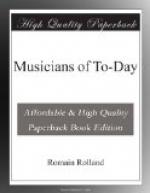Not enough attention has been drawn to the classical nobility from which Berlioz’s art so spontaneously springs. It is not fully acknowledged that he was, of all nineteenth-century musicians, the one who had in the highest degree the sense of plastic beauty. Nor do people always recognise that he was a writer of sweet and flowing melodies. Weingartner expressed the surprise he felt when, imbued with current prejudice against Berlioz’s lack of melodic invention, he opened, by chance, the score of the overture of Benvenuto and found in that short composition, which barely takes ten minutes to play, not one or two, but four or five melodies of admirable richness and originality:—
“I began to laugh, both with pleasure at having discovered such a treasure, and with annoyance at finding how narrow human judgment is. Here I counted five themes, all of them plastic and expressive of personality; of admirable workmanship, varied in form, working up by degrees to a climax, and then finishing with strong effect. And this from a composer who was said by critics and the public to be devoid of creative power! From that day on there has been for me another great citizen in the republic of art."[74]
[Footnote 74: Musikfuehrer, 29 November, 1903.]
Before this, Berlioz had written in 1864:—
“It is quite easy for others to convince themselves that, without even limiting me to take a very short melody as the theme of a composition—as the greatest musicians have often done—I have always endeavoured to put a wealth of melody into my compositions. One may, of course, dispute the worth of these melodies, their distinction, originality, or charm—it is not for me to judge them—but to deny their existence is either unfair or foolish. They are often on a large scale; and an immature or short-sighted musical vision may not clearly distinguish their form; or, again, they may be accompanied by secondary melodies which, to a limited vision, may veil the form of the principal ones. Or, lastly, shallow musicians may find these melodies so unlike the funny little things that they call melodies, that they cannot bring themselves to give the same name to both."[75]
And what a splendid variety there is in these melodies: there is the song in Gluck’s style (Cassandre’s airs), the pure German lied (Marguerite’s song, “D’amour l’ardente flamme"), the Italian melody, after Bellini, in its most limpid and happy form (arietta of Arlequin in Benvenuto), the broad Wagnerian phrase (finale of Romeo), the folk-song (chorus of shepherds in L’Enfance du Christ), and the freest and most modern recitative (the monologues of Faust), which was Berlioz’s own invention, with its full development, its pliant outline, and its intricate nuances.[76]
[Footnote 75: Memoires, II, 361.]
[Footnote 76: M. Jean Marnold has remarked this genius for monody in Berlioz in his article on Hector Berlioz, musicien (Mercure de France, 15 January, and 1 February, 1905).]




